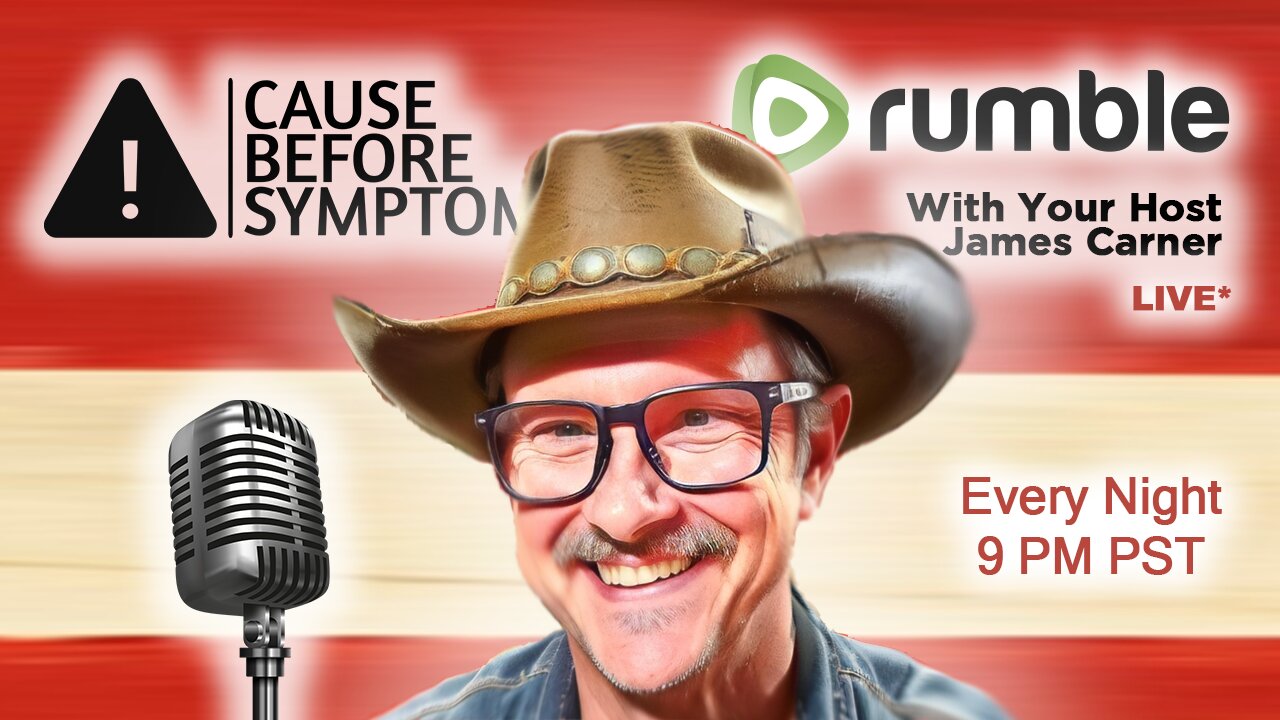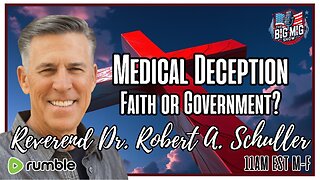Premium Only Content

The Heart: Portal, Plasma, Spirit, Gold
Cause Before Symptom - With Your Host James Carner
The Heart: Portal, Plasma, Spirit, Gold
Rudolph Steiner whose teachings led to anthroposophical Medicine biodynamic farming and the Waldorf School, said that the heart is a seven-sided regular form that sits in an imaginary box in the chest which means that all seven sides are identical. Plato described five platonic solids and Steiner said there was a sixth one. He also said that the heart is not a pump. This fantastic claim was Vindicated by Frank Chester who figured out how to design a seven-sided form with the sixth platonic solid which is now called the chestahedron and it fits perfectly inside a cube at an angle of 36 deg off center to the left the exact same angle that the heart sits in the chest.
When submerged in water and spun, two counter rotating vortices are formed. Recent scientific Studies have shown that these two vortices facilitate the closing of the valves and when the vortices don't form properly, blood clots will appear. The man who unfolded a thousand Hearts Francisco Torrent-Guasp, discovered that the heart is a single muscular band folded over itself in a spiraling pattern. The heart itself is a vortex of tissue it is not a pump. It is a vortex machine. For centuries, it was believed that matter can only exist in three states such as water, which can exist as liquid, ice and Vapor. Human cells are 70% water, but most of this water is not in any of these three states.
We have recently learned that with water there is a fourth state. This fourth state is called the plasma State, gel phase exclusion zone or structured water and this is what pushes your blood through the entire cardiovascular system fueled by infrared energy from its environment. The water in our body becomes an electrical propulsion system. A certain percentage of the water in our body becomes structured water and the rest remains normal liquid water or bulk water. The structured water becomes negatively charged and forms the gelatinous outer walls of our capillaries veins and arteries. These negatively charged outer walls continuously propel the positively charged bulk water within carrying the blood with it.
This propulsion system will run indefinitely so long as it stays charged and the way you charge it is with the Earth's electromagnetic field infrared energy and positive thought. The work of Dr misaru imoto has scientifically demonstrated that water exposed to loving human words and thoughts is transformed into its natural hexagonal shape it becomes structured at a molecular level based on our positive intention. This new model shows that it is is the blood that pumps the heart, not the other way around, and in order to keep the flow strong and healthy, our best medicine is to connect to the Earth get sunlight, love ourselves and love one another with physical touch.
Victor shurger spent his life studying water and found that in the natural world, water will always create vortices along its path. Shia Briger learned that this spiral action is what structures the water in nature and that when we are subjected to Modern man-made water treatment, it loses its structure. Shia Briger's work led him to believe that one could generate energy out of a Vortex. He described it as an energy implosion as opposed to an energy explosion. Dr Tom Cowan who has written about this in human heart Cosmic heart, has an interesting theory which may explain the saying “a heart of gold”. Another recent discovery is that gold in its purest form does not appear to be gold at all under the right conditions. Normal physical gold can be transformed into a fine white powder known as monatomic gold. This monatomic gold has been studied by multiple Advanced Laboratories and it has very strange properties. It can be made to levitate and disappear. Monatomic gold is super conductive and many would argue that this is what the Alchemists were after. One of the ways of turning metallic gold into monatomic gold is by putting it through a high-speed Vortex. When this transformation occurs there is a flash of light and a 44% loss in weight. Dr Cowen believes that the Trace Amounts of gold in our blood is transformed into monatomic gold as it travels through the double vortices in the heart creating the spark of life.
The Bible says we are a bubble under water that surrounds us. The flat plain is also surrounded by water, too. We are pretty much trapped here. What science uncovered then censored it, seems to be the connection between the veil or fourth dimension is plasma, which could be monotomic gold. No one in medicine can say where plasma comes from. This is the yellow submarine the Beattles were talking about. The yellow shell or firmament is gold and what seaparates us from that domension is our heart which seems to pull plasma monotomic gold from the firmamant. But that’s just fantasy right? Gold seems to be the element we all want and are mesmerized by it. It’s the most hoarded element on the planet. It’s also the most buried and hidden substance of this earth, meaning, people go to great lengths to hide their riches from the world and vaults aren’t as safe.
Let’s see what Academia says about the heart. Your muscular heart, the main organ in your cardiovascular system, is vital for life. Its parts work together to move blood through your body in a coordinated way. It constantly sends oxygen to your cells and takes away waste. Many conditions can affect this organ and keep it from working well. The heart is a fist-sized organ that pumps blood throughout your body. It’s your circulatory system’s main organ. Muscle and tissue make up this powerhouse organ.
Your heart contains four muscular sections (chambers) that briefly hold blood before moving it. Electrical impulses make your heart beat, moving blood through these chambers. Your brain and nervous system direct your heart’s function.
What is the function of the heart?
Your heart’s main function is to move blood throughout your body. Blood brings oxygen and nutrients to your cells. It also takes away carbon dioxide and other waste so other organs can dispose of them.
Your heart also:
Controls the rhythm and speed of your heart rate.
Maintains your blood pressure.
Your heart works with these body systems to control your heart rate and other body functions:
Nervous system: Your nervous system helps control your heart rate. It sends signals that tell your heart to beat slower during rest and faster during stress.
Endocrine system: Your endocrine system sends out hormones. These hormones tell your blood vessels to constrict or relax, which affects your blood pressure. Hormones from your thyroid gland can also tell your heart to beat faster or slower.
Anatomy
What are the parts of the heart?
The parts of your heart are like the parts of a building. Your heart anatomy includes:
* Walls.
* Chambers that are like rooms.
* Valves that open and close like doors to the rooms.
* Blood vessels like plumbing pipes that run through a building.
* An electrical conduction system like electrical power that runs through a building.
Heart walls
Your heart walls are the muscles that contract (squeeze) and relax to send blood throughout your body. A layer of muscular tissue called the septum divides your heart walls into the left and right sides.
Your heart walls have three layers:
* Endocardium: Inner layer.
* Myocardium: Muscular middle layer.
* Epicardium: Protective outer layer.
The epicardium is one layer of your pericardium. The pericardium is a protective sac that covers your entire heart. It produces fluid to lubricate your heart and keep it from rubbing against other organs.
Heart chambers
Your heart has four separate chambers. You have two chambers on the top (atrium, plural atria) and two on the bottom (ventricles), one on each side of your heart.
* Right atrium: Two large veins deliver oxygen-poor blood to your right atrium. The superior vena cava carries blood from your upper body. The inferior vena cava brings blood from your lower body. Then the right atrium pumps the blood to your right ventricle.
* Right ventricle: The lower right chamber pumps the oxygen-poor blood to your lungs through the pulmonary artery. The lungs reload the blood with oxygen.
* Left atrium: After the lungs fill your blood with oxygen, the pulmonary veins carry the blood to the left atrium. This upper chamber pumps the blood to your left ventricle.
* Left ventricle: The left ventricle is slightly larger than the right. It pumps oxygen-rich blood to the rest of your body.
Heart valves
Your heart valves are like doors between your heart chambers. They open and close to allow blood to flow through. They also keep your blood from moving in the wrong direction.
Atrioventricular valves
The atrioventricular (AV) valves open between your upper and lower heart chambers. They include:
Tricuspid valve: Door between your right atrium and right ventricle.
Mitral valve: Door between your left atrium and left ventricle.
Semilunar valves
Semilunar (SL) valves open when blood flows out of your ventricles. They include:
* Aortic valve: Opens when blood flows out of your left ventricle to your aorta (artery that carries oxygen-rich blood to your body).
* Pulmonary valve: Opens when blood flows from your right ventricle to your pulmonary arteries (the only arteries that carry oxygen-poor blood to your lungs).
Blood vessels
Your heart pumps blood through three types of blood vessels:
* Arteries carry oxygen-rich blood from your heart to your body’s tissues. The exception is your pulmonary arteries, which go to your lungs.
* Veins carry oxygen-poor blood back to your heart.
* Capillaries are small blood vessels where your body exchanges oxygen-rich and oxygen-poor blood.
Coronary arteries
Your heart receives nutrients through a network of coronary arteries. These arteries run along your heart’s surface. They serve the heart itself and include the:
* Left coronary artery: Divides into two branches (the circumflex artery and the left anterior descending artery).
* Circumflex artery: Supplies blood to the left atrium and the side and back of the left ventricle.
* Left anterior descending artery (LAD): Supplies blood to the front and bottom of the left ventricle and the front of the septum.
* Right coronary artery (RCA): Supplies blood to the right atrium, right ventricle, bottom portion of the left ventricle and back of the septum.
Electrical conduction system
Your heart’s conduction system is like the electrical wiring of a building. It controls the rhythm and pace of your heartbeat. Signals start at the top of your heart and move down to the bottom. Your conduction system includes:
* Sinoatrial (SA) node: Sends the signals that make your heart beat.
* Atrioventricular (AV) node: Carries electrical signals from your heart’s upper chambers to its lower ones.
* Left bundle branch: Sends electric impulses to your left ventricle.
* Right bundle branch: Sends electric impulses to your right ventricle.
* Bundle of His: Sends impulses from your AV node to the Purkinje fibers.
* Purkinje fibers: Make your heart ventricles contract and pump out blood.
Where is your heart located?
Your heart is in the front of your chest. It sits slightly behind and to the left of your sternum (breastbone), which is in the middle of your chest.
Your heart is slightly on the left side of your body. It sits between your right and left lungs. The left lung is slightly smaller to make room for the heart in your left chest. Your rib cage protects your heart.
What does your heart look like?
Your heart looks a little bit like an upside-down pyramid with rounded edges. Large blood vessels go into and out of your heart to bring blood into and away from your heart. They connect your heart to the rest of your body, which it supplies with blood and oxygen.
How big is your heart?
Everyone’s heart is a slightly different size. Generally, your heart is about the same size as your fist. On average, an adult’s heart weighs about 10 ounces. Your heart may weigh a little more or a little less, depending on your body size and sex.
The reticuloendothelial cells of the liver are in charge of plasma protein synthesis in adults. The bone marrow, degenerating blood cells, general body tissue cells, and the spleen also contribute to the formation of plasma proteins. Gamma globulins originate from B lymphocytes, which in turn form immunoglobulins.
So academia steers clear of gold and the heart being a supernatural valve that separates us from the spiritual world. Gold actually once was a rejuvinator medine and people would ingest it for health benefits.
The heart as a portal
New age websites claim the heart is the portal to the spiritual realm. According to new ager Nicole Calder “The heart is an energetic and physical centre through which we can access our intuitive intelligence from the unified field. Intuition is connectivity to the wisdom, knowingness and higher perspective that is available to us all from the non-local field. By having clear connection to our intuition, we can choose to live in higher vibrational expressions like love, compassion, peace and express those frequencies out into our environment and the human collective. In these states we are happier, healthier, actively aligned with our heart space, our Higher Self and our ability to raise our consciousness. When our heart, mind and body are in a regulated coherent state, we can access these higher vibrational states more easefully.
The heart is the portal to our highest intelligence, and this has been acknowledged in ancient cultures for centuries. The symbology of the heart, even in the modern unconscious world represents love. It is a remembrance that our true nature is unconditional love, all else is illusion.
‘Divine unconditional love has no opposite. It just is. It is truth. It is the frequency of Source energy. Fear is born when love cannot be perceived in the present moment. You are love, you are whole, and you are held in sacred light.’ (Nicole Calder)
Energetically the heart chakra or heart space, represents the integration point between the lower three chakras aligned with the body/mind/ego experience, the density, and the higher three chakras, aligned with our spiritual energetic nature. It provides a bridge of frequency between higher intuitive awareness through the non-local field and our physical self, allowing for the divine to be anchored or embodied into this density experience.
The supportive scientific research of the HeartMath Institute (HMI) is substantiating the intelligence of the heart. The heart and the cranial brain are in constant two-way communication. The heart utilises neurological, hormonal, pulse waves and electromagnetic fields for communication. The heart is its own nervous system with a dense cluster of 40 000 neural cells termed the ‘heart brain’ or ‘little brain’. It has been shown that the heart transmits more information to the brain than the brain does to the heart and via the pulse waves of the heart contraction and electrical impulses generated, helps to synchronise every cell in the body including the brain. This confirms the spiritual notion that the privileged mind/ego is secondary to the intelligence of the heart.
HMI has also supported the concept of the heart as a portal by showing the heart is precognitive. A three-part study in 2004 by Rollin McCraty, a psycho-physiologist at HMI showed by measuring the physiology of the participants, the heart received intuitive information precognitively about emotionally activating stimuli seconds before the stimuli were shown to participants. This was then communicated to the brain to allow other body systems to have a response. The heart is our portal to non-local intuition.
Everything is energy and is in constant motion or movement. The smallest particle to the universe itself creates electromagnetic fields of energy, or toroidal fields. We are living in and communicating with quantum fields within fields within fields. The electromagnetic field of the anatomical heart is astoundingly 500 times more powerful than the cranial brain, extending three feet outside the physical body, and can be detected in a person nearby via an electrocardiogram. With this information, we can see we are interconnected to everything and everyone. We are constantly influencing our surroundings and communicating with the unified field to interpret and co-create our reality.
With this knowledge we can see that the quality of our emotional and vibrational state matters. We are all One, and the human collective is facing purposeful challenge in the form of density consciousness that is arising for alchemisation. As individuals we must be holding optimal states of coherence and flow between our heart, mind and body to allow for our experiences to be met with connection to our guiding intuition and a higher perspective. When we intentionally cultivate feelings of love, compassion, gratitude, joy, we expand our heart field, create ease and regulation in our body, allowing us to intentionally and purposefully effect the fields we are interacting in.
We are ascending, shifting into higher states of consciousness. By individually anchoring the vibration of our heart space onto the planet and living our lives connected to our intuitive flow, we have the potential to shift more easefully as a human collective. But we must meet our experiences consciously, with a remembrance of what we are. When density consciousness is met with compassion, it may illuminate the possibility of a different choice: love. Love for self, love for others. But there must be those that are willing to demonstrate free will by choosing to move from judgement to love and compassion, holding a space of possibility for others.
Hold the higher perspective that all experiences are perfectly co-created for our love and expansion. If in the moment we can identify the underlying frequency we are experiencing, we can meet this and the other person with love and gratitude. This unexpected grace shifts the energy, it shifts the heart, and creates an opportunity to open to their higher consciousness. We are here to shift and ascend as a collective. Some hold awareness before others. With this comes a responsibility of awareness. To open your heart to others, to bathe them in the light of love and compassion has immeasurable flow on effects in the field, even in the smallest of interactions. See past the human and feel into your eternal nature and theirs. We are all One and the frequency of the heartspace can be the spark of healing and transformation.”
Gold as an elixer
In 1929, a French doctor discovered gold did indeed have anti-inflammatory properties; since then, gold compounds have been used in drugs to treat rheumatoid arthritis. (Studies also have been made on the efficacy of gold to treat or ease the symptoms of cervical cancer, prostate cancer, Alzheimer’s, nerve sensitivity restoration, and aging.)
Gold in suspension was swallowed for various medical problems since the 1500s when Paracelsus, the “father of toxicology,” pioneered the use of minerals in medicine. By the middle of the 16th century, gold leaf on food became so common in some European countries that it had to be limited to two dishes per meal so as not to exhaust the gold supply.
Radioactive gold particles also have been used in cancer treatment. They are used to apply careful amounts of radiation to targeted areas of cancer treatment. One study found that it could be used on prostate cancer but without the typical side effects of normal radiation.
While eating gold has recently become trendy in the West, it’s nothing new. In 3000 B.C., the Egyptians believed that gold was the skin and flesh of the gods, so they consumed it for mental, bodily, and spiritual purification, seeing gold as a gateway to immortality. Gold- or silver-wrapped sweets have been popular in India and Southeast Asia for centuries.
At the height of the Renaissance, European noblemen sought to impress their guests by decorating their food (bread, oysters, quail, carp) with gold leaf at banquets and weddings. In Renaissance Venice, gold-covered, sugared almonds were offered after the meal in the belief that gold strengthened the heart and protected against rheumatism—a belief that later proved to have some merit.
But while gold obviously makes every dish more gorgeous, it can’t make them nutritious. “There appear to be no harmful effects if gold leaf is eaten,” says Mark Grimwade, consultant to the Worshipful Company of Goldsmiths in London. “This is not surprising because gold is chemically inert.” Some cultures, and modern enthusiasts, believe that gold can “replenish minerals” in the body, but this is fantastical, as is the so-called “monoatomic gold” marketed as a cure for almost everything. “Edible gold leaf has no taste, texture, calories, or expiration date,” says science journalist L.V. Anderson. “Pure gold passes through the human digestive system without being absorbed into the body. Since 24-karat gold is very soft and fragile, most edible gold—whether leaf, flakes, or dust—also contains a little bit of silver, which is also inert.”
In short, gold clearly feeds the eye more than the body; all the same, the European Union has approved gold and silver leaf as “food additives” (code E 174 and E 175). The Centers for Disease Control and Prevention in the U.S. only certifies them as non-toxic. They are also kosher.
Plasma is the liquid component of blood
Red and white blood cells and platelets float in your plasma, and together make up whole blood. Plasma is the often forgotten part of blood. White blood cells, red blood cells, and platelets are important to body function. But plasma also plays a key role. This fluid carries the blood components throughout the body. Plasma is the largest part of your blood. It, makes up more than half (about 55%) of its overall content. When separated from the rest of the blood, plasma is a light yellow liquid. Plasma carries water, salts and enzymes.
The main role of plasma is to take nutrients, hormones, and proteins to the parts of the body that need it. Cells also put their waste products into the plasma. The plasma then helps remove this waste from the body. Blood plasma also carries all parts of the blood through your circulatory system. Plasma is a critical part of the treatment for many serious health problems. This is why there are blood drives asking people to donate blood plasma.
Along with water, salt, and enzymes, plasma also contains important components. These include antibodies, clotting factors, and the proteins albumin and fibrinogen. When you donate blood, healthcare providers can separate these vital parts from your plasma. These parts can then be concentrated into various products. These products are then used as treatments that can help save the lives of people suffering from burns, shock, trauma, and other medical emergencies.
The proteins and antibodies in plasma are also used in therapies for rare chronic conditions. These include autoimmune disorders and hemophilia. People with these conditions can live long and productive lives because of the treatments. In fact, some health organizations call plasma "the gift of life." The concept of ghosts is primarily rooted in folklore, cultural beliefs, and personal experiences rather than scientific evidence. However, if we were to speculate on what ghosts might be "made of" if they existed, several theories could be considered:
Energy Forms: Some theories suggest that ghosts could be manifestations of energy. This could be in the form of electromagnetic fields or other types of energy that are not currently understood. The idea is that these energy forms could interact with the physical world in ways that might be perceived as ghostly phenomena.
Plasma: Plasma is a state of matter where gases are energized to the point that electrons are freed from atoms, creating a mixture of charged particles. Some have speculated that if ghosts were to exist, they could be composed of a form of plasma, allowing for visibility and interaction with the environment.
Quantum Theories: Some interpretations of quantum mechanics suggest the possibility of non-physical entities. This could include concepts like parallel universes or alternate dimensions, where "ghosts" might be seen as projections or echoes of beings from those realms.
Psychic or Consciousness-Based: Another theory posits that ghosts could be manifestations of consciousness or residual energy from individuals who have passed away. This idea leans more into metaphysical territory rather than scientific, suggesting that consciousness might persist in some form after death.
Natural Phenomena: Many ghost sightings can often be attributed to natural phenomena, such as infrasound (low-frequency sound waves), electromagnetic fields, or even psychological factors like pareidolia (the tendency to see patterns, like faces, in random stimuli).
Ghosts & The Heart
Ultimately, the existence of ghosts is not supported by scientific evidence, and any speculation about their composition remains hypothetical.
There is some speculation within metaphysics that such a thing cannot be authenticated, and that it falls under a Duhem–Quine thesis by its very nature. One issue is that something can’t simply exist in a tangible way without some physical structure? Is it similar in effect to string theory (much like a radio, do certain aspects of the phenomenon only manifest when they are “attuned” to the observer phenomenon?) Would such phenomenon only manifest in recognition with an observer; could an animal per se see or hear something due to higher sensitivity to certain light spectrum waves or auditory recognition? What is “emitting” that frequency wave?
From what I’ve observed I would hypothesize that the nature of the phenomenon usually relies upon electromagnetism; things such as metal, or earth matter might have some influence into the nature of the phenomenon, or the oft-mentioned claim of ghost phenomenon occurring only at night. Perhaps much like a fog occurring when the sun goes down during the day, energy—like water moisture—radiates from dissipation in solar heat surface areas? The atmosphere itself becomes more stilled due to less activity in the atmosphere, or less noise is generated in the atmosphere; and cortisol due to heightened senses cause people to more readily attribute such phenomenon to an isolated incident, that they might be more likely to overlook during the daytime?
One thing to question is “Can Humans Harvest The Sun's Energy Directly Like Plants?” and not be based on a biological function in optimal state, just as sunlight is involved with vitamin D synthesis; could life exists and be enervated without relying on biological or photosynthesis processes, similar to powering a crystal receiver radio purely with radio wave? Are people’s belief in EMF and paranormal phenomenon the result of insufficient knowledge of EMF detection? Whether such a thing can be believed, a person named Hira Ratan Manek claimed to have lived purely on sunlight.
Ectoplasm is clearly a term used by what I assume was largely fraudulent claims made a century ago, and the general consensus of such phenomenon in various locations as Paulding lights or Marfa lights are generally believed by locals to be headlamps by those who have lived in that area for decades (if a car light is visible, it must invariably follow the same direction it is heading, and if it disappears then that would require some explanation for the path of trajectory being disrupted?) Evidently a test was performed using spectroscopy and it’s assumed that they were automobile light illusion that had their 15 minutes of fame. Even though these sightings were noticed before automobiles, it has a common component of things appearing visible in a light spectrum, and history is replete with phenomenon believed to be attributed to paranormal which are later understood in contexts of natural events, such as Bizarre Earthquake Lights Finally Explained attributed to an electromagnetic disruption caused by geological activity. I should also mention that many reports exist of these same types of light orbs following trains, appearing in front of cars as they are driving, or the famous case of the “foo fighter” (not the music group.)
So what then explains the intelligent manifestation of the phenomenon, if it seems evident from EVP recordings that something using known language to communicate, somehow manifests itself in an audio recording or as some human form using film photography?
Ectoplasm
Ectoplasm (also exoplasm) is the non-granulated outer part of a cell's cytoplasm, while endoplasm is its often granulated inner layer. It is clear, and protects as well as transports things within the cell.[1] Moreover, large numbers of actin filaments frequently occur in the ectoplasm, which form an elastic support for the cell membrane.[2] It contains actin and myosin microfilaments. Amoebae form an outer zone of cytoplasm, known as ectoplasm, where actin and myosin association help move it forward.[3]
The term comes from the Ancient Greek words ἐκτός ektos, "outside" and πλάσμα plasma, "anything formed."
Ectoplasm is the outer portion of an amoeba's cytoplasm, while endoplasm is the inner portion of the cytoplasm.
Ectoplasm, in occultism, a mysterious, usually light-coloured, viscous substance that is said to exude from the body of a spiritualist medium in trance and may then take the shape of a face, a hand, or a complete body. It is normally visible only in the darkened atmosphere of a séance (q.v.). Ectoplasm is said to be the substance involved in the materialization of spiritual bodies, and the levitation of material objects is commonly explained by the gradual buildup of columns of ectoplasm underneath the objects. At the end of a séance the ectoplasm disappears, allegedly by returning to the medium’s body.
The Victorian Era is actually where ectoplasm originates. The term was coined by Charles Ritchet in 1894, and mediums would "secrete" it as proof they had actually contacted ghosts. As a result, it has become a very popular trope in ghost stories and fanfictions (even fanfics for series where the ghosts didn't have Ectoplasm, such as Luigi's Mansion).
To most of us, the definition of ectoplasm is "a slime in 'Ghostbusters.'" To a more select group of people, it is the outer layer of cytoplasm that helps make up an amoeba. And to an even smaller subset of the population, ectoplasm is a substance that secretes off spirits -- or their earthbound medium -- and might just help that medium produce spooky, otherworldly feats for awed witnesses.
Now. Guess which explanation for ectoplasm is actually rooted in reality? It doesn't exactly take a biologist to figure out that we should probably go for the amoeba one, as it does sound vaguely familiar -- in that high school science class kind of way. Also, ghosts aren't real.
But don't tell that to the small, yet vocal, part of our audience who chose the latter definition. Because for a long time, ectoplasm was absolutely something mysterious but not altogether insane -- if you were hanging out at séances, that is. In a séance, a medium supposedly communicates (or helps others communicate with) a spirit. During the 19th and early 20th centuries, séances were a popular fad. People were quite into the idea that souls or spirits were floating around us, waiting to be nudged with a question
[source: Crystal].
Ectoplasm emerged as a nifty way for mediums to "show" people that those spirits really did exist and could physically manifest. Usually, this ectoplasm would kind of ooze from the body -- the mouth, an ear or (let's just be polite) any other orifice you could imagine. This ectoplasm sometimes looked like gauzy, cloth-like material or mysteriously took the form of faces of the spirit that was being invited to talk [source: Taylor].
Or perhaps not so mysteriously, considering that some of the most famous "physical" mediums were later found to be cutting out pictures from newspapers and using the cover of darkness (ectoplasm would supposedly disappear in light, you see) to "manifest" the stuff. Still others would just swallow some cloth or paper and spit it up for effect. A kind of gross trick, but not really from another dimension, after all [source: Taylor].
It's pretty easy to find lots of photographic "evidence" of the kind of spooky ectoplasm mediums were into. And it probably isn't a huge surprise that people took these pictures as proof; in the burgeoning days of photography, it was easy to assume that white splotches on a badly rendered picture were ghosts or that the carefully staged pictures were candid.
Lesson being, for those asking you for a definition of ectoplasm at a party, you can really judge what kinds of people they are by which definition they cleave to.
What is ectoplasm?
Ectoplasm is a supernatural term coined by Charles Richet in 1894. In the context of paranormal theories, it describes a viscous magical substance that, supposedly, erupts from the body in the form of spiritual energy when exteriorized during a spiritualistic séance. It’s sort of an attempt to connect the living with dead spirits.
Is ectoplasm real?
Most people in the 21st century might think ectoplasm is fake, but during the 19th and 20th centuries, it was a huge fad for researchers. People were quite into spirituality, supernatural beliefs and the possibility of talking to otherworldly spirits.
How does ectoplasm emerge?
Ectoplasm began as the spooky way to talk to ghosts and spirits. Such spirits were thought to emerge physically to show their presence to mediums. Theoretically, ectoplasm serves as a bridge for spirits to emerge from orifices in the body like the mouth or ears and take the form of mysterious-looking sticky material. This substance supposedly takes the form of a face to talk to the callers.
Where does gold come from?
Scientists believe all the gold on Earth formed in supernovae and neutron star collisions that occurred before the solar system formed. In these events, gold formed during the r-process. Gold sank to the Earth's core during the planet's formation. It's only accessible today because of asteroid bombardment.
To learn about the origin of gold, we must first turn our gaze to the cosmos. Gold is not native to our planet alone; it is a cosmic traveler that finds its roots in the cataclysmic events occurring in the far reaches of the universe. So, how is gold formed, and where does gold come from? The birth of gold is linked to the dramatic demise of massive stars in explosive supernovae and neutron star collisions.
When a star exhausts its nuclear fuel or collides with another star, it undergoes a stellar explosion, scattering elements forged in its core across the cosmos. These elements include heavy elements like gold, which form during the intense heat and pressure within the star. The released debris, now enriched with these precious metals, disperses into space, creating vast interstellar clouds. These interstellar clouds are the material that eventually forms into other stars and planets, such as Earth.
A star’s shine is created by nuclear fusion. Pulled together by gravity, hydrogen atoms slam together to form helium atoms, which release enormous amounts of energy in the form of heat and light. Eventually, the hydrogen in the star’s core runs out, and gravity causes the star to collapse. What happens next depends on the star’s mass, but gold is formed when the collapse creates a massive shockwave.
During the explosion, a tremendous amount of energy creates heavy elements through the rapid neutron-capture process. The process occurs when one or more heavy seed nuclei rapidly capture the available neutrons faster than radioactive decay can begin. The heavy elements created, including gold, are transported through space to their destination or become the beginning formations of new stars or planetary systems.
The collision of neutron stars can also cause the rapid neutron-capture or r-process. Throughout the galaxy, some neutron stars are stuck in a binary star system, orbiting each other. Over time, they get closer and closer before eventually merging. The mass amount of energy produced during a collision creates the same conditions as a supernova, allowing heavy elements such as gold to be formed. Scientists witnessed a gravitational wave caused by a neutron star collision in 2017. They could detect heavy elements upwards of 16,000 times the mass of the Earth. These detections included gold formations amounting to 3-10 times the mass of Earth.
Gold is a well-known precious metal labeled as Au on the periodic table of elements. With an atomic number of 79, it has been an essential part of human history since 3000 BCE. The journey of gold to Earth is far from straightforward. Billions of years ago, our planet formed from the remnants of a protoplanetary disk, a swirling mass of gas and dust surrounding the young Sun. The early Earth was a seething cauldron of molten rock devoid of the metals we prize today.
Heavy elements, including gold, began to migrate towards the core through various geological processes as our planet cooled over eons. One key player in this cosmic ballet is the element iron. Gold has a natural affinity for iron, and during the differentiation of the Earth’s layers, it selectively combined with iron to sink into the core. Most of the gold within our planet is deep within the core, inaccessible to us due to the extreme depth and heat of Earth’s core. So, where does the gold we use come from if we cannot reach most of it?
While a significant amount of gold resides deep within the Earth’s core, what we mine today is often closer to the Earth’s surface. Scientists generally agree that the gold in the planet’s crust came from the same place as the gold in Earth’s core: space. The consensus is that meteors transported gold and deposited it throughout Earth’s crust during a bombardment. Through hydrothermal processes and forces of erosion, these gold deposits became discoverable.
Hydrothermal processes play a crucial role in bringing gold closer to accessible depths. These processes involve the movement of hot fluids through the Earth’s crust, dissolving and transporting minerals, including gold, along the way. These fluids could be molten lava in a volcanic area.
When these mineral-laden fluids encounter cooler conditions or suitable host rocks, they deposit the dissolved gold. This can lead to gold deposits or veins forming in various geological settings, such as quartz veins, which are common hosts for gold. The intricate dance of temperature, pressure, and chemical reactions orchestrates the creation of gold deposits that await discovery.
In addition to hydrothermal processes, gold can be transported and deposited by the forces of erosion and weathering. Rivers, streams, and other water bodies have been nature’s gold pans for centuries, carrying minute gold particles from their sources to new locations.
As water courses through gold-rich areas, it wears away rocks and releases the gold, which, being dense, settles in riverbeds as placer deposits. The famous Klondike Gold Rush of the late 19th century in the Yukon, Canada, is a testament to the allure of placer deposits, where prospectors braved harsh conditions in pursuit of elusive gold nuggets.
The story of gold spans billions of years, traversing the vastness of space and the depths of our planet. From the fiery furnaces of long-gone stars to the intricate dance of geological processes on Earth, gold’s journey is a testament to the cosmic alchemy that shapes our world.
As we continue to marvel at the brilliance of gold in our jewelry, coins, and investments, let us remember its cosmic origins and the geological processes that bring it within our reach. The allure of gold is not just in its monetary value but in the profound connection it shares with the universe and the intricate workings of our planet.
Gold is Conductive
Gold is needed for computers. It’s a great conducitve material. One of the reasons why it is used in electronics is because of its electrical conductivity properties. Gold is highly conductive, meaning electricity can easily flow through it with minimal resistance. Copper, silver and aluminum are also conductive, but gold offers a superior level of electrical conductivity.
Is plasma conductive?
The properties of plasma are very different to those of a normal gas. For example, a plasma is electrically conductive; its motion can be influenced by electric and magnetic fields. Plasma has a very high electrical conductivity. Plasma is more readily influenced by electric and magnetic fields than by gravity. The motion of electrons and ions in plasma produces its own electric and magnetic fields. The presence of charged particles makes plasma electrically conductive, with the dynamics of individual particles and macroscopic plasma motion governed by collective electromagnetic fields and very sensitive to externally applied fields.[7] The response of plasma to electromagnetic fields is used in many modern devices and technologies, such as plasma televisions or plasma etching.
Could the human heart be a vessel to pull plasma from the heavens for the purpose to use for blood? Withoiut plasma, the blood cells could not travel throughout the body. We know the bible says we are made of 3 things. The body, soul and spirit. Perhaps the spirit comes in through the heart via monotomic plasma and it is the substance that allows the spoirit to remain inside the body. Plasma uses our spirit energy instead of electricity and this is the mystery of where our spirit resides. Our spirit is the life and the bible say the blood or plasma is just that. It’s a part of God. Perhaps god breathed ectoplasm into Adam to give him life? He gave him part of his spriit which is liquid gold from heaven. Just a theory, but I do think there is something here. I hope someone takes this information and digs even deeper than I.
Sources
Gemini AI
https://www.youtube.com/watch?app=desktop&v=hkjzvw977jc
https://my.clevelandclinic.org/health/body/21704-heart
https://www.quora.com/If-ghosts-did-exist-what-would-they-be-made-of-Some-form-of-plasma-an-electromagnetic-field-Something-else
https://craftsmanship.net/sidebar/gold-as-a-rejuvinator-myths-and-facts/
https://science.howstuffworks.com/science-vs-myth/unexplained-phenomena/ectoplasm.htm
https://www.britannica.com/topic/ectoplasm-occultism
https://en.wikipedia.org/wiki/Ectoplasm_(cell_biology)
https://learn.apmex.com/learning-guide/science/how-is-gold-formed/
https://en.wikipedia.org/wiki/Plasma_(physics)
-
 LIVE
LIVE
Akademiks
31 minutes agoDay 3/30. Diddy Trial Day 16. Jane Doe to take the Stand. Possibly this is 50 Cent Baby moms?
1,464 watching -

VINCE
2 hours agoAre Trump's Budget Cuts Bills The Best Way To Do It? | Episode 57 - 06/04/25
59.6K45 -
 LIVE
LIVE
Bannons War Room
3 months agoWarRoom Live
15,682 watching -
 LIVE
LIVE
LFA TV
14 hours agoLFA TV ALL DAY STREAM - WEDNESDAY 6/4/25
4,097 watching -
 DVR
DVR
NEWSMAX
2 hours agoThe Gerry Callahan Show LIVE (06/04/2025) | NEWSMAX Podcasts
1.25K -
 LIVE
LIVE
The Big Mig™
4 hours agoReverend Dr. Robert A. Schuller MEDICAL DECEPTION Faith in God or Government? |EP571
4,644 watching -
 1:10:07
1:10:07
Dear America
3 hours agoElon DESTROYS Congress Over Trump’s Spending Bill!! Is This The Worst Congress Ever?!
70.4K138 -
 11:44
11:44
James Klüg
18 hours agoPortland State University: Professor ASSAULTS Us For Talking About THIS…
3334 -
 2:08:07
2:08:07
Matt Kohrs
10 hours agoStocks Set To Rocket, Breaking News & Live Trading $1M || The MK Show
19.1K4 -
 LIVE
LIVE
Badlands Media
10 hours agoBadlands Daily: June 4, 2025
4,860 watching